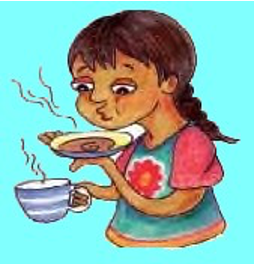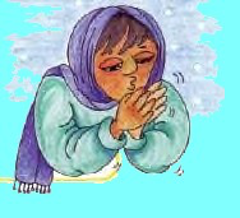NCERT Solutions for Class 5 EVS Chapter 15 Blow hot, blow cold
Find pdf of NCERT Solutions for Class 5 EVS Chapter 15 Blow hot, blow cold prepared by expert teachers. All the questions asked in the exercise of Blow hot, and blow cold are solved with the required details.
A Brief Introduction to Chapter 15 Blow hot, blow cold
Chapter 15 Blow hot, blow cold- In this chapter, we will read about hotness and coldness first., Then we will learn how to blow a whistle with the exhale of air. Also, why will we also read about melodious and pleasant trips? and At last, we will cover how a snake tells the direction of the flow of air and also about breathing-Hot and Cold
Find pdf of NCERT Solutions for Class 5 EVS Chapter 15 Blow Hot, Blow Cold
Page No 141:
Question Do This:
Miya Balishtiye was confused when he saw the woodcutter blowing on his cold hands to make them warm and on the hot potatoes to cool them.
· Have you warmed your hands in winter by blowing on them when they are cold? How does it feel?
· Blow hard from your mouth onto your hands. How did you find the air from your mouth as compared to the air around? Was it hotter, or cooler?
· Now put your hands at some distance from your mouth, and blow again. Does the air from your mouth feel warm? Why?
Answer:
Disclaimer: This section comprises questions that has to be answered by a student based upon his own imagination. Considering this, the answer to the same has not been provided.
Page No 142:
Question Think and Tell:
· Can you think of any other way in which you use the warmth from your breath?
· Fold a piece of cloth 3-4 times. Now bring it close to your mouth and blow hard on it. Did the cloth become warm?
· Balishtiye saw that the woodcutter was trying to cool the hot potatoes by blowing on them. What would have happened if he had eaten the potatoes without cooling them?
· Have you ever burnt your tongue when you ate or drank something that was too hot? How do you cool some food when it is too hot?
· If you were to cool these three hot things – dal, roti, rice – in which ways would you do so?
· Mini tried to cool her tea by blowing on it. Which do you think will be hotter – Mini’s tea or the air she blew from her mouth?

· Sonu was feeling very cold. He kept blowing on to his hands. Now think and write, which will be cooler – Sonu’s hands or his breath?

· For what other things do you blow air from your mouth?
Answer:
· Disclaimer: This question has to be answered by a student based upon his own imagination. Keeping this in mind, the answer to the same has not been provided.
Yes, the cloth became warm. This is because the air we exhale is warm.
His mouth would have got burnt from the hot potatoes if he had eaten the potatoes without cooling them. The air coming out of his mouth is colder as compared to the hot potatoes. So, he used air from his mouth to cool down the hot potatoes.
We blow on some food to cool them or we leave them as it is uncovered to let them cool down in the surrounding atmosphere. We put some hot food in refrigerator also to cool them. Disclaimer: The first part of this question has to be answered by a student based upon his own experience. Considering this, the answer to the same has not been provided. The answer to the second part of the question is merely a sample. The students’ answers can vary from this. Also the answer of two students can vary from each other.
Dal and rice can be cooled by keeping them at room temperature or by keeping them in refrigerators. Also, we can use a spoon to cool them. For cooling roti, we can tear it a little and leave it for a minute. In this manner the heat gets released into the atmosphere and then we can eat it.
Mini’s tea will be hotter than the air coming out of her mouth. She is cooling down the hot tea from the cooler air coming from her mouth.
Sonu’s hands will be cooler than his breath. He used the warmer air coming out of his mouth to warm his cold hands.
Disclaimer: This question has to be answered by a student based upon his own knowledge and imagination. Considering the sustenance of this thinking process, the answer to the same has not been provided.
Page No 143: Question Blow in Different Was:
Make whistles of the things given below. Write in a sequence–from the loudest to the softest whistle.
– Wrapper of a toffee___________
– A leaf___________
– A balloon___________
– The cap of a pen ___________
– Any other thing___________
Have you seen people playing different musical instruments like flute, dholak, been …., guitar, mridang, etc.? Can you recognize their sounds with your eyes closed? Find out more about these musical instruments. Collect their pictures too.
Answer:
Disclaimer: This question has to be answered by a student based upon his own observation. Considering the sustenance of this thinking process, the answer to the same has not been provided.
Page No 144:
Question Write:
Can you name some things which produce melodious or pleasing sounds when we blow into them?
Answer:
Flutes, Harmonica (mouth organ), bag pipes, whistles, been are some of the musical instruments that produce melodious or pleasing sounds when we blow into them.
Disclaimer: This is a sample answer. The answer of the students can vary from this. Also, the answers of two students can vary from each other.
Question Do this and discuss:
· Have you seen someone blowing on their spectacles to wipe them clean? How does there from the mouth help in cleaning the spectacles?
· Take a glass. Bring it near your mouth and blow hard on it. Do this two or three times. Does the glass look hazy?
· Can you make a mirror hazy in the same way? Can you tell by touching the mirror what made it hazy? Is the air you blew from your mouth dry or wet?
· Put your hand on your chest. When you breathe in, does your chest come out or go in.
Measure your chest
– Take a deep breath in
– Ask your friend to measure your chest with a thread.
Measurement ___________
– Now breathe out. Again ask your friend to measure your chest.
Measurement _____________
– Was there any difference in the two measurements of your chest?
Answer:
Disclaimer: The purpose of this question is to introduce the children to the method of science. This involves certain prior imagination followed
by experimentation and logical deductions. Considering the sustenance of this process of imagination and experimentation the answer to this question has not been provided.
Page No 145: Question How Many Breaths in:
Put your finger under your nose. Can you feel any air when you breathe out from your nose?
– Count how many times in one minute do you breathe in and breathe out.
– Jump 30 times. Did you feel breathless?
– Now again count how many times in one minute you breathed in and out.
– What was the difference in your count before and after jumping.
Answer:
Disclaimer: The purpose of this question is to introduce the children to the method of science. This involves certain prior imagination followed by experimentation and logical deductions. Considering the sustenance of this process of imagination and experimentation the answer to this question has not been provided.
Page No 146: Question What We Have Learnt:
· While playing, Amit hit a wall. His forehead was swollen. Didi immediately folded a scarf (4-5 times), blew on it and kept it on Amit’s forehead. Why do you think didi did this?
· We blow to cool hot things as well as to warm them. Give examples of each.
Answer:
· Didi blew warmer air from her mouth on the cloth to make the cloth warmer. This warm cloth reduces the swelling when put on the swollen portion of the head.
· Example of cooling things by blowing air: We blow air from our mouth to cool the food so that it can be eaten easily without burning our mouth. Example of warming things by blowing air: During winters we blow air from our mouth on our cool hands to warm them.
· Disclaimer: This is a sample answer. The answer of the student may differ from this answer. Also the answer of one student may differ from the others. Students can answer this question based on their own experiences.